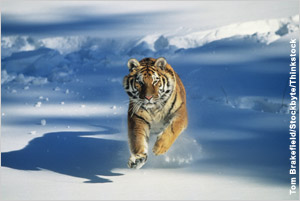eJournal USA: Go Wild! Coming Together for Conservation
30 November 2012

An Amur tiger charges through the snow in Russia. In the last century, the world has lost 97 percent of its wild tigers, which makes this big cat an endangered species.
Every year, thousands of animal species become extinct. Animals that once roamed the Earth in abundance are permanently disappearing from our planet at a heart-stopping pace. Scientists estimate that the current rate of extinction is 1,000 times greater than it would normally be because of one factor. What has caused this rapid rise in extinctions? The alarmingly simple answer: humans.
What’s Going Wrong?
We are consuming Earth’s natural resources faster than they can be replenished. We are destroying animals’ habitats, their food, water and air — as well as the animals themselves — at an unsustainable rate. As more birds' nests are cleared to build skyscrapers, rivers are drained for parking lots and elephants are slaughtered to make trinkets, the number and diversity of animals contracts.
In addition to our high resource consumption, an even more disturbing trend is threatening our wildlife: trafficking. The illicit trade of animals and their body parts on the black market is growing. Rising demand for products derived from some of the world’s most iconic land animals — such as elephants, rhinos and tigers — threatens not only these species, but the peace, health and prosperity of the people who live near them.
Why We Should Care
When an entire species of animal goes extinct, the loss is greater than the sum of animals lost. Although we may consider the animal world to be separate from our own, our lives and theirs are intertwined, connected by a million threads. Plants, animals, people and the environment together constitute a biological community — an ecosystem — in which each part depends on the other for survival. When one part of the community is thrown off-balance or eliminated, the entire system suffers. Further, wildlife trafficking reduces the security of citizens and the profits of legitimate businesses.
Everyone Can Help
Even though humans are wildlife’s greatest threat, we are also their only hope. All over the world individuals and small groups, as well as large organizations, corporations and governments, are doing their part to ensure a more secure future for our wildlife — and for us. From curbing demand for animal byproducts, establishing and enforcing laws against illegal trafficking, and volunteering with conservation organizations that help protect endangered species, conservation heroes are combating the threats facing Earth’s animals in a variety of ways.
No act of conservation is too small to be significant. We may not be able to bring back the species we have already lost, but there are many more that are on the brink of extinction that need our immediate attention and action. Don’t be part of the problem. Be the solution: Respect and protect Earth’s wildlife.
CONTENTS
